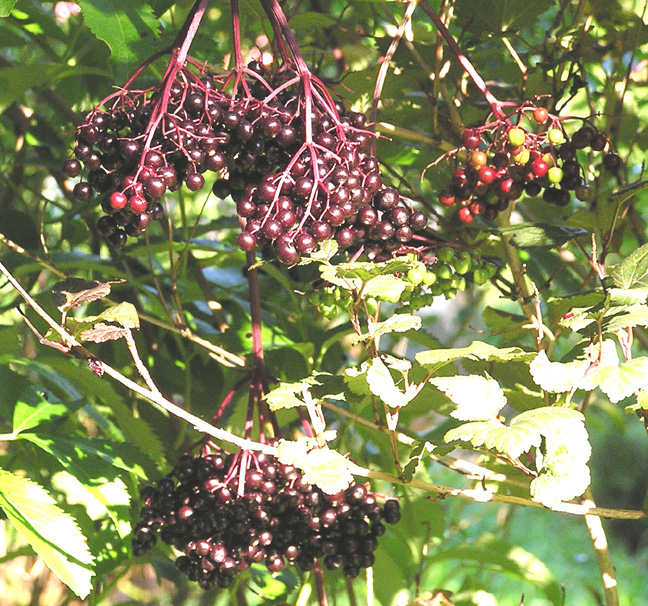ElderberrySambucus nigra

From An Herbalist in the Kitchen
Other Common or Ethnic Names
- Black Elder, Bore Tree, Bour Tree, Common Elder, Eldrum, Ellhorn, European Alder, Hylantree, Hylder, Pipe Tree
- The old herbal’s and apothecaries' name for Elderberries was "Fructus Sambuci."
- Arabic: Balasan
- Bulgaria: Bez
- Denmark: Hyld
- France: Sureau
- Germany: Holander, Holunder, Hollunder
- Greece: Sampoukou
- Italy: Sambuco, Sammucu, Zammucu
- Japan: Niwatoko No Mi
- Mexico: Canilolerro; Sauco (blossoms)
- Norway: Svarthyll
- Poland: Bez Czarny
- Russia: Buzina Chornaya
- Spain: Sauc, Sauco
Related Species
- Sambucus canadensis: American Elder, Black-berried Elder, Common Elder, Sweet Elder
- Sambucus cerulea: Blue Elder
- Sambucus mexicana: Mexican Elder
- Sambucus pubens: Red-fruited Elder
Cultivars
- 'Albo-variegata,' 'Argentea,' 'Aurea,' 'Aurea-variegata,' 'Laciata,' 'Variegata'
Growth Habits
Deciduous shrub
Origin: North America
Range: Europe, North America, north Africa, western Asia
Culinary Uses
The berries are, of course, used to make wine. It is actually fairly decent--with good red color and lots of tannin. It tastes a bit like chianti, though it does have a slight mustiness that is unavoidable whenever you use elderberries. Elderberries were, at one time, known as "the English Grape."
Roots are sometimes brewed as tea or shredded for use in salads. They are also preserved in honey.
The flowers, known as “blow,” are also used to make wine. The berries are used in the Italian liqueur Sambuca. An English Cheddar called Windsor Red is flavored, not with port, but with Elderberry Wine.
The flowers have been used in infused vinegars.
A pleasant country dessert is made by dipping the entire flower-head in batter and deep-frying to make a lacy, crispelle-like fritter.
They are usually sprinkled with powdered sugar, and sometimes with orange juice, as well. In Italy the same dish, known there as
"Fritelle di Fiori di Sambuca," is made, adding a little grappa to the batter.
In this country, a simpler dish is sometimes made by adding separated flowers to crepe batter.
The sweetened juice can be made into jellies, especially if given a little Tannic "edge" with Staghorn Sumac
(see Comments under Staghorn Sumac) or Lemon Balm.
Sambucus nigra and Sambucus canadensis berries contain b-Carotene, plus several fruit acids and sugars, Quercitin, Rutin and Tannin. Elderberry blossoms contain Campherol, p-Coumaric Acid, Rutin (up to 49,000 ppm), Sambunigrin and Tannins.
Other Uses
The stems used to be made into spiles for tapping maple trees for their sap. The hardwood stalks have a large core of soft pith that is easily removed. All of the bark and cambium is scraped off, also. They have relatively uniform diameter making it a simple matter to drill the correct sized holes, without constantly changing the bit.
Several parts of the plant have been used to produce vegetable dyestuffs. The berries were once used to adulterate wines, especially Port. Portugal banned the cultivation of Elderberries in the eighteenth century, in an effort to protect the reputation of its wine industry.
Comments
Red-fruited Elder, Sambucus pubens, is poisonous.
Even the edible species are not entirely benign -- roots, stems and unripe fruit should be avoided.
The FDA restricts its use to alcoholic beverages.
Some enzymes act on Sambucus berries, liberating Prussic Acid, a deadly poison.
While this substance is eliminated by commercial processors, their safety measures are not readily available in the home.
